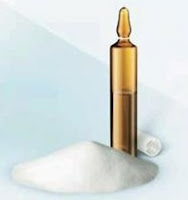Bone Cement Implantation Syndrome (BCIS)
Bone Cement constituents:
-Bone cement is an acrylic polymer that is formed by mixing two sterile components:
a) Powder:
1-Polymer: Polymethyl methacrylate/co-polymer (PMMA)
2-Initiator: Benzoyl peroxide (BPO)
b) Liquid:
1-Monomer: Methyl methacrylate (MMA)
2-Accelerator: N, N-Dimethyl para-toluidine (DMPT)/diMethyl para-toluidine (DMpt)
-To make the cement radiopaque, a contrast agent is added, either zirconium dioxide (ZrO₂) or barium sulphate (BaSO₄).
-When the two components are mixed, the liquid monomer polymerizes around the pre-polymerized powder particles to form hardened PMMA. During this polymerization process, heat is generated, due to an exothermic reaction, and reaches temperatures of around 82–86 °C.
Incidence:
-The incidence of BCIS in cemented orthopedic procedures is approximately 20%.
-The incidence of a severe reaction resulting in cardiovascular collapse within this group is 0.5-1.7%.
Orthopedic procedures incidence:
-Cemented hemiarthroplasty (highest incidence)
-Total hip replacement
-Knee replacement surgery
BCIS typically occurs during:
-Bone cementation and prosthesis insertion
-Femoral reaming (before cementation)
-Joint reduction and limb tourniquet deflation (after cementation)
Patients at high risk of cardio-respiratory compromise:
-Male sex
-Increasing age
-ASA class III / IV
-Significant cardiopulmonary disease
-Chronic obstructive pulmonary disease
-Use of diuretics
-Use of warfarin
Conditions that can increase the incidence of BCIS:
-Osteoporosis, Bone metastasis, and Concomitant hip fractures.
These conditions may be associated with increased or abnormal vascular channels, through which marrow contents can more readily migrate into the circulation, resulting in emboli.
Pathophysiology of BCIS:
a) Embolization of the Medullary Contents:
-During surgical cementation and prosthesis insertion, the cement is intentionally pressurized to force it into the interstices of the bone, to improve bonding between the cement and bone.
-The cement then expands in the space between the bone and the prosthesis, further pressurizing air and the medullary contents, forcing them into circulation. These embolic contents include fat, marrow, cement, air, bone particles, and aggregates of platelets and fibrin.
-When these medullary contents embolize, they may reach the lungs, heart, and/or coronary circulation, causing the characteristic hypoxia and right ventricular dysfunction, leading to hypotension.
b) Histamine release, Hypersensitivity, and Complement activation:
-Contact with bone cement (Methyl Methacrylate), leads to an increase in blood levels of anaphylactoid complements (C3a and C5a) and histamine, which are potent mediators of vasoconstriction and bronchoconstriction.
-These mediators result in an increase in pulmonary vascular resistance, causing ventilation/perfusion disturbances, hypoxia, right ventricular failure, and cardiogenic shock.
Clinical Picture:
-Hypoxia
-Sudden loss of arterial blood pressure
-Pulmonary hypertension
-Arrhythmias
-Loss of consciousness
-Cardiac arrest
-Under general anesthesia, a significant drop in systolic blood pressure (SBP) may herald cardiovascular collapse, whilst a sudden drop in end-tidal pCO₂ may indicate right heart failure leading to a catastrophic reduction in cardiac output.
-In an awake patient under a regional anesthetic, early signs of BCIS may include dyspnea and/or altered sensorium.
BCIS Severity Spectrum:
a) Non-fulminant BCIS:
-Characterized by a significant, yet transient, reduction in arterial oxygen saturation and SBP in the peri-cementation period.
b) Fulminant BCIS:
-With profound intraoperative cardiovascular changes, progressing to; arrhythmias, shock, or cardiac arrest.
Classification of BCIS Severity: based on the degree of hypoxia, hypotension, and conscious level (Table 1)
 |
| Table 1: Classification of BCIS Severity |
Prophylaxis:
a) Anesthesia:
1-Ensure adequate hemodynamic optimization pre- and intra-operatively
2-Keep SBP within 20% of the pre-induction value
3-Prepare vasopressors in case of cardiovascular collapse
4-Confirm awareness that cement is about to be prepared/applied
5-Maintain vigilance for cardiorespiratory compromise
b) Orthopedic:
1-Inform the anesthetist before cement application
2-Wash and dry the femoral canal
3-Apply cement retrograde, utilizing a suction catheter and intramedullary plug in the femoral shaft
4-Avoid excessive pressurization (3rd generation technique)
Management:
-Administration of 100% inspired oxygen is first-line therapy, with airway control if necessary.
-Invasive hemodynamic monitoring (if not already in place), should be established.
-In cases of severe BCIS (when the patient has been arrested, or in a peri-arrest condition), standard advanced cardiopulmonary life support (ACLS) algorithms and procedures should be followed.
-Fluid resuscitation to maintain Rt. Ventricle preload, and inotropes to support ventricular contractility.
-Vasopressors (such as Phenylephrine and Noradrenaline) primarily cause peripheral vasoconstriction, and increase aortic blood pressure, which in turn supports coronary artery blood flow, and thus improves myocardial perfusion and contractility.
-Use of vasopressors and inotropes should be continued into the postoperative period as necessary, under the management of the intensive care unit (ICU).

























